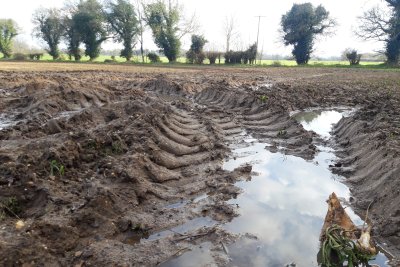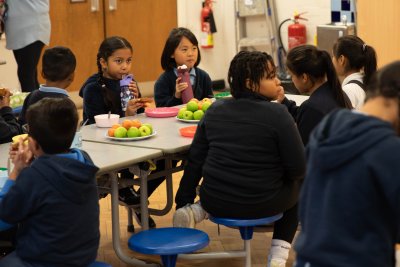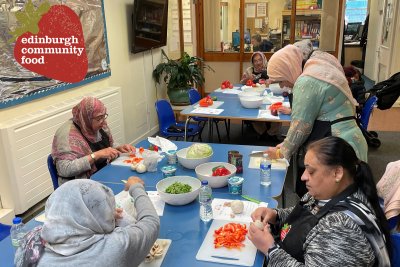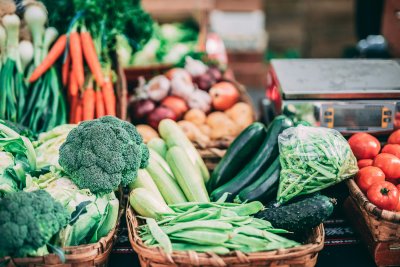Growing more veg, but where, and how?
When a successful fruit and veg box scheme in Calderdale wanted to expand the amount of locally produced food in their boxes, they were faced with a shortage of land in an area dominated by livestock farming. In this blog we look at innovative examples to overcome shortage of land, often the first barrier when it comes to producing more local food.
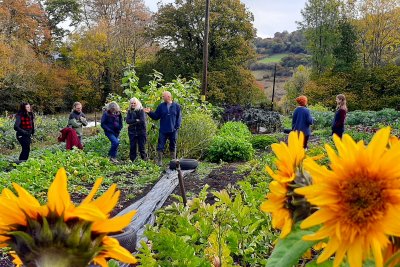
Pennine Cropshare, run by Burnley Food Link, is a successful veg bag scheme delivering 200 fruit and veg bags a week across Calderdale, Burnley and Pendle, containing mostly certified organic produce. There is strong demand for their service, but the vast majority of their produce is sourced from wholesalers, local or further afield. Motivated by a desire to include more locally grown produce in their boxes, and start a growing revolution at their doorstep, Burnley Food Link faced the shortage of land and local growers in an area dominated by livestock farming. This was the motivation behind their recent initiative Grow and Graze, a scheme to match livestock farmers with land to spare with horticultural growers.
Our Food 1200 is an innovative approach in Wales to overcome the barrier of access to land. Members of Burnley Food Link and Sustain visited Our Food 1200 and Welsh growers in their network to learn from their experience.
Why more veg?
We need to eat and grow more vegetables in the UK. According to Veg Facts 2021, children and teenagers consume too few vegetables with 29 per cent of 5-10 year olds eating less than a portion of veg a day and only six per cent of 11-16 year olds eating the recommended amount of vegetables. There are economic disparities at play; richest 20 per cent eat on average one more portion of veg compared to the poorest 20 per cent. An increase in veg intake is key for improving the health of the nation, but it would also have economic and climate benefits. If the population started to consume the recommended 5 a day of fruit and veg it would support British farmers and would increase the value of UK veg production by £261 million as well as decrease greenhouse gas emissions by 8.2 per cent.
Despite the allure of high-tech solutions, from vertical farming to heated greenhouses, or large-scale specialised production, the solution is staring us in the face in the form of modern small-scale horticultural production.
With relatively small starting and running costs, small-scale horticulture is more likely to be grown to higher environmental standards.
For example, a recent survey of local veg box schemes found the majority were small scale producers producing organically. And for every £1 spent in a veg box or farmers’ market there is £3.70 in economic, social and environmental returns (based on Growing Communities example).
During our visit, people talked enthusiastically about formulas to run small scale horticultural enterprises successfully, draw enough income and provide other services such as biodiversity, soil fertility, and volunteering and training opportunities. From growing directly on compost, no-dig, a certain bed size and plant spacing just the right size to deter weeds, such strategies are often associated with the ‘market garden’ model and have been well described by specialist authors such as Richard Perkins or Charles Dowding in this and other side of the Atlantic.
Our Food 1200
Coupled with absence of Government support to small scale agriculture, access to land is a major barrier to small scale horticulture.
The aim of this new initiative is to find 1200 acres of land, attract and develop new commercial growers and support small farms alongside growing demand for locally grown food. The name was inspired by the fact that 1200 acres is all it would take to produce enough seasonal fruit and veg for every household in Monmouthshire and the Brecon Beacons. This would be the foundation of a new local food economy.
Their take is that this land should be earmarked for modern small-farm regenerative horticulture for local markets, an approach to farming that puts more back into the environment and society than it takes out. It attracts and develops new commercial growers, can be profitable, creates jobs (one per acre), produces a lot of food in a small area (a football pitch provides for 80 families), produces fresh healthy food, reduces food miles and fixes carbon in the soil. Selling locally keeps money in the local economy, builds community among farmers and other residents and creates the supply chains that all farmers can use.
Matchmaking land owners and growers is a complex process. There are important requirements in terms of land such as road access, electricity, water and accommodation. Prospective growers, on the other hand, need to have sound business plans and a clear path for their enterprise to ensure they will remain profitable and are able to not just pay a rent and generate a profit but maintain or build land fertility over time. That is maybe why in their first year, Our Food 1200 only matched four growers and landowners from 43 growers’ applications and 32 offers of land.
In Calderdale, Grow and Graze has been met with scepticism by the local farming community. There is a resistance to the notion that vegetables can be grown at any scale despite the fact that Pennine Cropshare has two local growers supplying significant produce, one of whom considers he makes a good living. However, it does seem that growers, particularly new entrants, are prepared to accept less remuneration to do something they love.
Growing is considered a way of life rather than a job.
To facilitate match making, Grow and Graze has taken the route of engaging growers to prepare design plans for prospective offers of land and has received funding from Sustainable Food Places to help pay for this process. After an initial expression of interest, this helps the landowner better understand what will be happening on their land. At the time of the visit, the first Grow and Graze plan was shared with the hosts from Our Food 1200 who agreed it could be a very useful tool to help broker the relationship between grower and farmer as well as to demonstrate the practical implications of the necessary infrastructure involved in constructing a successful market garden.
Growing on rented land
David and Katherine of Langtons Farm in Crickhowell were matched with local landowner John via Our Food 1200 who agreed to rent them four acres of land. While renting their land might not be appealing to some, farmers like John see it as an innovative premise. John moved from the traditional beef and lamb farming to a more diversified model of organic beef farming and apple orchards. He was attracted by David and Katherine’s ambition and sound business plans and is happy with their arrangement so far.
Langtons Farm sells 100 certified organic veg boxes a week, with half of the produce grown on site and the remaining bought locally to other growers and wholesalers. They have big ambitions for their business and want to expand to 200 boxes. Besides David and Katherine, an additional family member works on the farm part-time. They grow organically and on top of that are working towards regenerative farming certification by Greener World, one of only 50 farms around the world to pilot this certification. They are justly proud of the unrivalled quality of some of their produce such as carrots and salad leaves, which cannot be found in supermarkets because they travel from farm to plate in just one day. For other produce, they offer a price guarantee to match the organic range at Marks & Spencer.
Rented land has some advantages but it also has some drawbacks. Being on rented land means whatever permanent infrastructure such as cold stores or packing warehouse they decide to install, needs planning permission, and needs to be removed when their tenancy agreement comes to an end. That means they are using temporary infrastructure such as a marquees and generator instead. During the warm months they live in a caravan on site but move to a home a few miles away in the colder homes.
Growing on own land
During our field visit, we visited farmers in the Our Food 1200 network who own their own land. Here, the challenges are different but not less difficult.
Rob and Zoe, of Tir Awen Market Garden, started farming a one-acre field in April 2021 they bought with their savings in the village they have been living for 16 years after volunteering at Langtons. They had savings from previous jobs that allowed them to buy the land out right and they rely on part-time work to supplement their income. For now, however, the farm is their main source of income. They operate as a CSA and their 36/37 members pay a fee for a share of their harvest. Their objective is to grow to around 50 members, at which point they estimate their business will be profitable enough to make a living for the family. Beyond 50 members, they would have to sell the surplus to food service or find other routes to market and would need additional staff and different logistics.
Their biggest barrier is not technical or land but delays in planning permission for their request to install polytunnels and build a home in the field under One Planet Development. Until they can build a home in the field, they have to travel back and forth to their main home a few miles away which makes family life difficult. The Welsh Government has a unique policy to support One Planet Development. Through Technical Advice Note 6 (TAN 6) and Planning Policy Wales (PPW) it sets out land use planning policies to support sustainable communities, at present in a rural context. One Planet Developments are Low Impact Development principles in the Welsh context and exemplars of sustainable development. Characteristic of a ‘One Planet’ Community include affordable housing for various sizes of household; buildings that are at least Zero Carbon throughout their entire life-cycle; close-to-zero waste; 100 per cent renewable energy; land-based enterprises to satisfy around 65 per cent of the minimum needs of the occupants, among others.
Alice and Jonny of Orchard Acre Market Garden, farm half-an-acre of land which they inherited. They operate as a CSA and have 32 members. Unlike the other two growers, they supply only six months a year. They are in an ideal situation in terms of land: their family home and growing field are in the same site. On the other end, the small size of their operation results in them having to draw income from other work in the other six months of the year. They are currently weighing their options and looking at diversifying to work with statutory bodies to provide community services. They are currently working to achieve organic certification after the Soil Association introduced a lower tier fee for smaller growers of £415. Our Food 1200 will further subsidise growers so the fee is only just over £200. Their vision is inspiring and summarises the aims of Our Food 1200:
every village should have their box scheme.
Next steps
Meeting the growers in Monmouthshire has helped Grow and Graze understand how different models of market gardening in terms of scale and structure can be successful. In turn, this equips the initiative to be able to advise and support new growers in Calderdale. Although we can offer a substantial market for would be growers through Pennine Cropshare (200-300 customers), we are aware that a CSA structure with 30-40 members may better suit some people’s ambition.
In comparing the two projects, the Calderdale campaign at present is much less ambitious than 1200 acres but the visit has highlighted the pros and cons associated with each of the locations and population demographics. Monmouthshire has Grade 1 and 2 land, ideal for veg growing and much more flat acreage. On the other hand, the population is very dispersed meaning that the nearest urban connotation to supply would be Cardiff incurring a round trip of 100 miles.
Calderdale has a concentrated population but is peri-urban growing at any scale realistic when the land is Grade 4 and 5 and there is very little flat ground? The skeptics believe we should concentrate on livestock for land use and continue to source vegetables from West Lancashire which boasts a tradition of successful veg growing at scale but involves a round trip of 80 miles. The over-riding question of ‘how local is local’ remains.
Grow and Graze is optimistic that veg and livestock can exist synergistically in Calderdale but we need to do both much better.
Whether either scheme can achieve the ideal of a patch work of market gardens serving their immediate community of 40 – 100 people remains to be seen.
If you are interested in buying sustainably grown fruit and veg check growers near you at Better Food Traders.
A huge thank you to Chloe Masefield, Our Food 1200 and Marianne Fisher, Monmouthshire Food Partnership coordiantor for facilitating our field visit.
Published Monday 14 November 2022
Veg Cities: We need your help to get your city or local area growing, cooking, selling and saving more vegetables.
